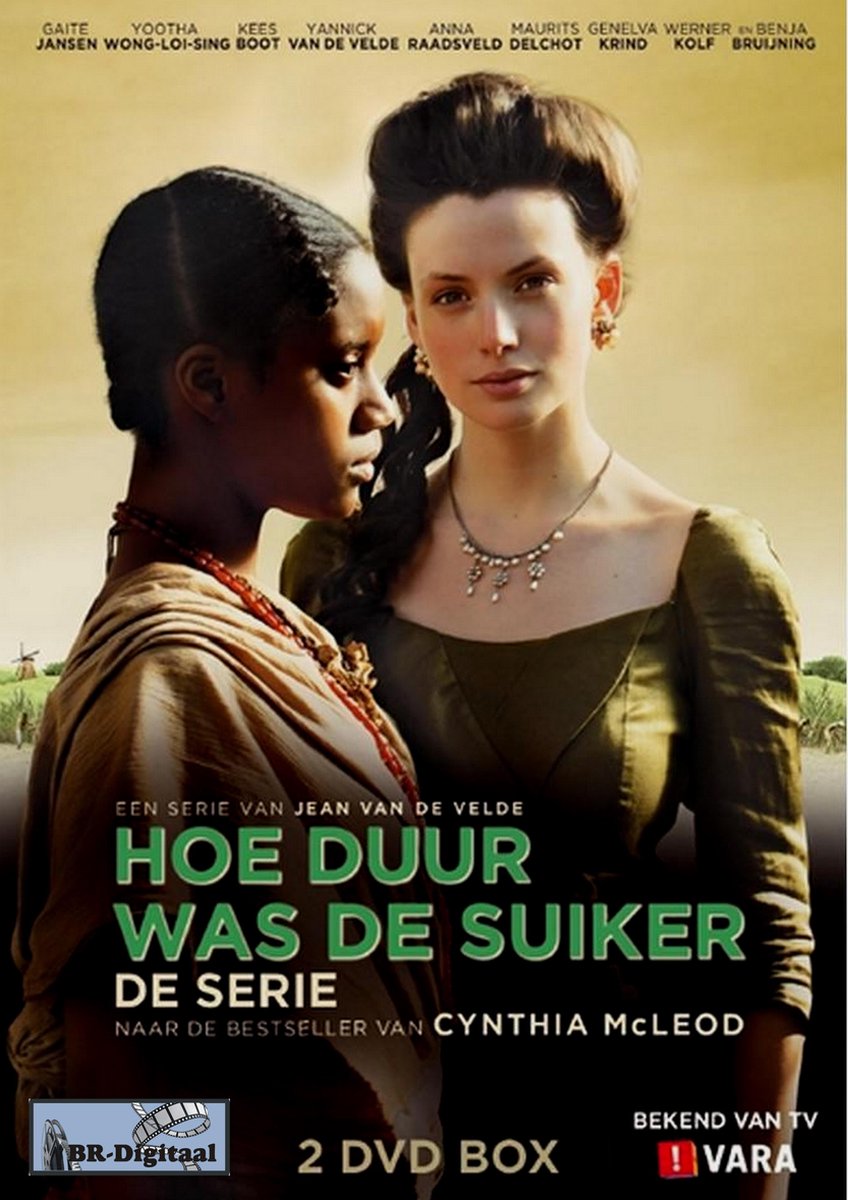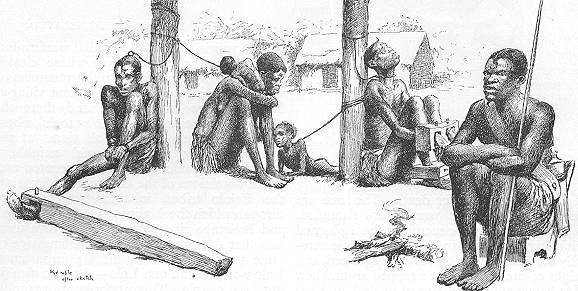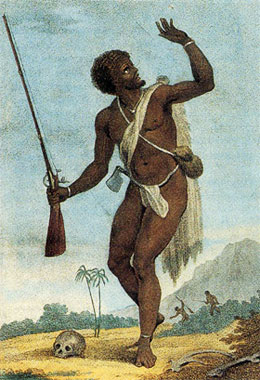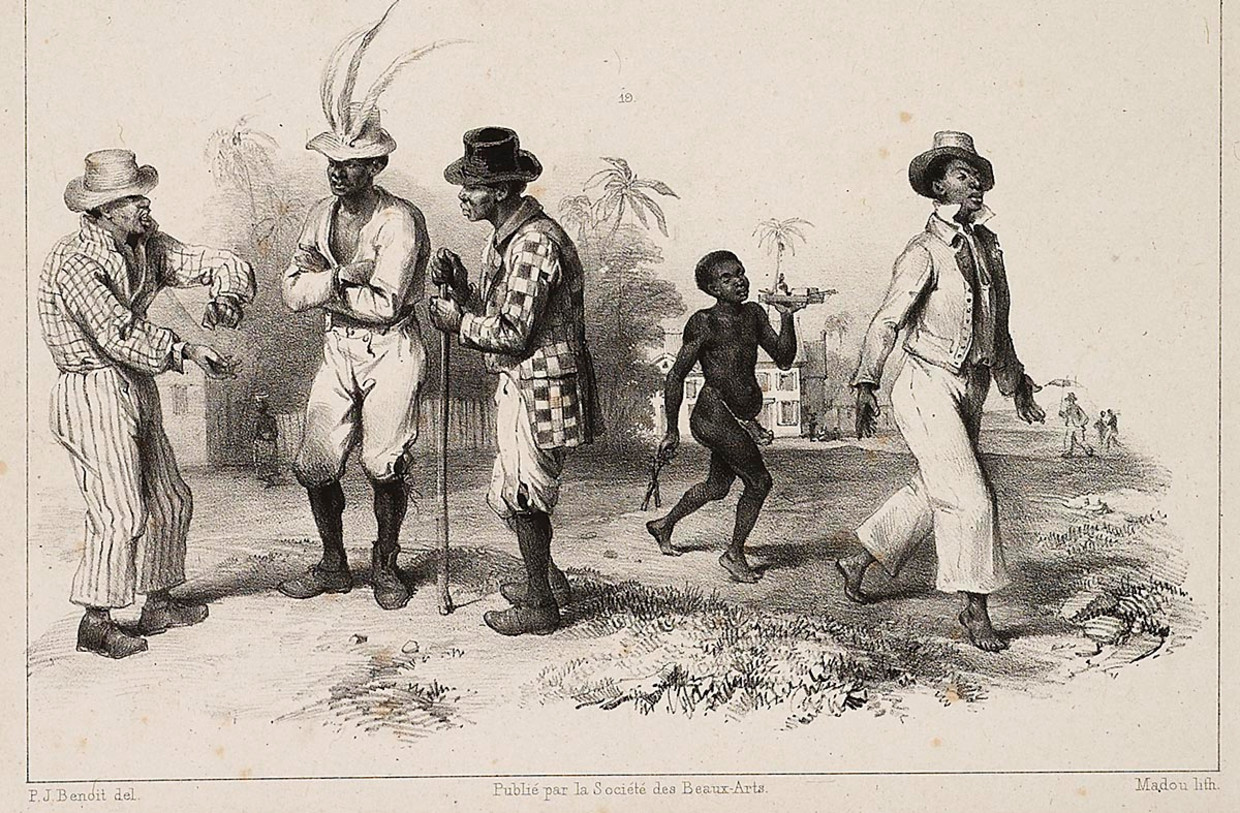|
|
Post by pieter on Aug 22, 2020 17:49:23 GMT -7
 "How expensive was de Sugar" (Hoe duur was de suiker) tells the compelling story of two young women in eighteenth-century Suriname: the white Sarith (Gaite Jansen) and her black slave girl Mini-Mini (Yootha Wong-Loi-Sing). While Sarith grows bitter due to the hard life in the colony, Mini-Mini gets her own chance for happiness. Can and does she dare to seize it at the expense of her mistress? How Expensive was the Sugar is based on the successful novel by Cynthia Mc Leod. The film is written and directed by Jean van de Velde, who was previously responsible for Wit licht (White Light) and De Kleine Blonde Dood (The Little Blond Death).Colonial period in SurinameBeginning in the 16th century, French, Spanish and English explorers visited the area. A century later, Dutch and English settlers established plantation colonies along the many rivers in the fertile Guiana plains. The earliest documented colony in Guiana was an English settlement named Marshall's Creek along the Suriname River. After that there was another short-lived English colony called Willoughbyland that lasted from 1650 to 1674. "How expensive was de Sugar" (Hoe duur was de suiker) tells the compelling story of two young women in eighteenth-century Suriname: the white Sarith (Gaite Jansen) and her black slave girl Mini-Mini (Yootha Wong-Loi-Sing). While Sarith grows bitter due to the hard life in the colony, Mini-Mini gets her own chance for happiness. Can and does she dare to seize it at the expense of her mistress? How Expensive was the Sugar is based on the successful novel by Cynthia Mc Leod. The film is written and directed by Jean van de Velde, who was previously responsible for Wit licht (White Light) and De Kleine Blonde Dood (The Little Blond Death).Colonial period in SurinameBeginning in the 16th century, French, Spanish and English explorers visited the area. A century later, Dutch and English settlers established plantation colonies along the many rivers in the fertile Guiana plains. The earliest documented colony in Guiana was an English settlement named Marshall's Creek along the Suriname River. After that there was another short-lived English colony called Willoughbyland that lasted from 1650 to 1674.
Disputes arose between the Dutch and the English for control of this territory. In 1667, during negotiations leading to the Treaty of Breda, the Dutch decided to keep the nascent plantation colony of Suriname they had gained from the English. The English were able to keep New Amsterdam, the main city of the former colony of New Netherland in North America on the mid-Atlantic coast. Already a cultural and economic hub in those days, they renamed it after the Duke of York: New York City.
In 1683, the Society of Suriname was founded by the city of Amsterdam, the Van Aerssen van Sommelsdijck family, and the Dutch West India Company. The society was chartered to manage and defend the colony. The planters of the colony relied heavily on African slaves to cultivate, harvest and process the commodity crops of coffee, cocoa, sugar cane and cotton plantations along the rivers. Planters' treatment of the slaves was notoriously brutal—historian C. R. Boxer wrote that "man's inhumanity to man just about reached its limits in Surinam"—and many slaves escaped the plantations. In November 1795, the Society was nationalized by the Batavian Republic and from then on, the Batavian Republic and its legal successors (the Kingdom of Holland and the Kingdom of the Netherlands) governed the territory as a national colony, barring a period of British occupation between 1799 and 1802, and between 1804 and 1816.


Slaves in the Dutch colony of Suriname
With the help of the native South Americans living in the adjoining rain forests, these runaway slaves established a new and unique culture in the interior that was highly successful in its own right. They were known collectively in English as Maroons, in French as Nèg'Marrons (literally meaning "brown negroes", that is "pale-skinned negroes"), and in Dutch as Marrons. The Maroons gradually developed several independent tribes through a process of ethnogenesis, as they were made up of slaves from different African ethnicities. These tribes include the Saramaka, Paramaka, Ndyuka or Aukan, Kwinti, Aluku or Boni, and Matawai.
The Maroons often raided plantations to recruit new members from the slaves and capture women, as well as to acquire weapons, food and supplies. They sometimes killed planters and their families in the raids; colonists built defenses, which were so important they were shown on 18th-century maps, but these were not sufficient.

The Maroons often raided plantations to recruit new members from the slaves and capture women
The colonists also mounted armed campaigns against the Maroons, who generally escaped through the rain forest, which they knew much better than did the colonists. To end hostilities, in the 18th century the European colonial authorities signed several peace treaties with different tribes. They granted the Maroons sovereign status and trade rights in their inland territories, giving them autonomy.Abolition of slavery From 1861 to 1863, with the American Civil War underway, and enslaved people escaping to Southern territory controlled by the Union, United States President Abraham Lincoln and his administration looked abroad for places to relocate people who were freed from enslavement and who wanted to leave the United States. It opened negotiations with the Dutch government regarding African-American emigration to and colonization of the Dutch colony of Suriname. Nothing came of the idea, and the idea was dropped after 1864. From 1861 to 1863, with the American Civil War underway, and enslaved people escaping to Southern territory controlled by the Union, United States President Abraham Lincoln and his administration looked abroad for places to relocate people who were freed from enslavement and who wanted to leave the United States. It opened negotiations with the Dutch government regarding African-American emigration to and colonization of the Dutch colony of Suriname. Nothing came of the idea, and the idea was dropped after 1864.
The Netherlands abolished slavery in Suriname in 1863, under a gradual process that required enslaved people to work on plantations for 10 transition years for minimal pay, which was considered as partial compensation for their masters. After 1873, most freedmen largely abandoned the plantations where they had worked for several generations in favor of the capital city, Paramaribo. Some of them bought the plantation they worked on, especially in the district of Para and Coronie. Their descendants still live on those grounds today. Several plantation owners did not pay their former enslaved workers in the ten years after 1863. They payed the workers with the owning rights of the ground of the plantation to get out of debt.

Freed slaves in Suriname
As a plantation colony, Suriname had an economy dependent on labor-intensive commodity crops. To make up for a shortage of labor, the Dutch recruited and transported contract or indentured laborer from the Dutch East Indies (modern Indonesia) and India (the latter through an arrangement with the British, who then ruled the area). In addition, during the late 19th and early 20th centuries, small numbers of laborers, mostly men, were recruited from China and the Middle East.
Although Suriname's population remains relatively small, because of this complex colonization and exploitation, it is one of the most ethnically and culturally diverse countries in the world. |
|
|
|
Post by pieter on Aug 22, 2020 18:04:35 GMT -7
Another film about the Dutch slave heritage is the movie "Tula: The Revolt" (2013) "Tula: The Revolt" is a Film about the leader of the largest slave revolt on the island of Curaçao in 1795, which was a Dutch colony at the time. Tula (Obi Abili), a slave on the island of Curacao, is increasingly aware of the inequality between his people and their white oppressors. When he learns from his lover Speranza (Natalie Simpson) that slavery has been abolished in Haiti, he pleads for freedom and equality between black and white. However, Tula does not get a hearing from his "plantation owner" Van Uytrecht (Jeroen Willems), but rather from his own people who, inspired by his willpower, abandon the work and join him. When news of the riot reaches Gouverneur De Veer (Jeroen Krabbé), he sends Dutch troops to the plantation under the command of Captain Van Westerholt (Derek de Lint). Tula, who has become the leader of the uprising against his will, wants to use words to find a peaceful solution. He soon realizes that he must let go of this idealistic idea and fight with the other slaves for freedom, equality, and brotherhood.History of the Netherlands AntillesSpanish-sponsored explorers discovered both the leeward (Alonso de Ojeda, 1499) and windward (Christopher Columbus, 1493) island groups. However, the Spanish Crown only founded settlements in the Leeward Islands. In the 17th century the islands were conquered by the Dutch West India Company and colonized by Dutch settlers. From the last quarter of the 17th century, the group consisted of six Dutch islands: Curaçao (settled in 1634), Aruba (settled in 1636), Bonaire (settled in 1636), Sint Eustatius (settled in 1636), Saba (settled in 1640) and Sint Maarten (settled in 1648). In the past, Anguilla (1631–1650), the present-day British Virgin Islands (1612–1672), St. Croix and Tobago had also been Dutch. During the American Revolution Sint Eustatius, along with Curaçao, was a major trade center in the Caribbean, with Sint Eustatius a major source of supplies for the Thirteen Colonies. It had been called "the Golden Rock" because of the number of wealthy merchants and volume of trade there. The British sacked its only town, Oranjestad (Orange town), in 1781 and the economy of the island never recovered. Unlike many other regions, few immigrants went to the Dutch islands, due to the weak economy. However, with the discovery of oil in Venezuela in the nineteenth century, British-Dutch Shell Oil Company established refineries in Curaçao, while the U.S. processed Venezuelan crude oil in Aruba. This resulted in booming economies on the two islands, which turned to bust in the 1980s when the oil refineries were closed. The various islands were united as a single country — the Netherlands Antilles — in 1954, under the Dutch crown. The country was dissolved on 10 October 2010.Curaçao and Sint Maarten became distinct constituent countries alongside Aruba which had become a distinct constituent country in 1986; whereas Bonaire, Sint Eustatius, and Saba (the "BES Islands") became special municipalities within the Netherlands proper. "Tula: The Revolt" is a Film about the leader of the largest slave revolt on the island of Curaçao in 1795, which was a Dutch colony at the time. Tula (Obi Abili), a slave on the island of Curacao, is increasingly aware of the inequality between his people and their white oppressors. When he learns from his lover Speranza (Natalie Simpson) that slavery has been abolished in Haiti, he pleads for freedom and equality between black and white. However, Tula does not get a hearing from his "plantation owner" Van Uytrecht (Jeroen Willems), but rather from his own people who, inspired by his willpower, abandon the work and join him. When news of the riot reaches Gouverneur De Veer (Jeroen Krabbé), he sends Dutch troops to the plantation under the command of Captain Van Westerholt (Derek de Lint). Tula, who has become the leader of the uprising against his will, wants to use words to find a peaceful solution. He soon realizes that he must let go of this idealistic idea and fight with the other slaves for freedom, equality, and brotherhood.History of the Netherlands AntillesSpanish-sponsored explorers discovered both the leeward (Alonso de Ojeda, 1499) and windward (Christopher Columbus, 1493) island groups. However, the Spanish Crown only founded settlements in the Leeward Islands. In the 17th century the islands were conquered by the Dutch West India Company and colonized by Dutch settlers. From the last quarter of the 17th century, the group consisted of six Dutch islands: Curaçao (settled in 1634), Aruba (settled in 1636), Bonaire (settled in 1636), Sint Eustatius (settled in 1636), Saba (settled in 1640) and Sint Maarten (settled in 1648). In the past, Anguilla (1631–1650), the present-day British Virgin Islands (1612–1672), St. Croix and Tobago had also been Dutch. During the American Revolution Sint Eustatius, along with Curaçao, was a major trade center in the Caribbean, with Sint Eustatius a major source of supplies for the Thirteen Colonies. It had been called "the Golden Rock" because of the number of wealthy merchants and volume of trade there. The British sacked its only town, Oranjestad (Orange town), in 1781 and the economy of the island never recovered. Unlike many other regions, few immigrants went to the Dutch islands, due to the weak economy. However, with the discovery of oil in Venezuela in the nineteenth century, British-Dutch Shell Oil Company established refineries in Curaçao, while the U.S. processed Venezuelan crude oil in Aruba. This resulted in booming economies on the two islands, which turned to bust in the 1980s when the oil refineries were closed. The various islands were united as a single country — the Netherlands Antilles — in 1954, under the Dutch crown. The country was dissolved on 10 October 2010.Curaçao and Sint Maarten became distinct constituent countries alongside Aruba which had become a distinct constituent country in 1986; whereas Bonaire, Sint Eustatius, and Saba (the "BES Islands") became special municipalities within the Netherlands proper.
From 1815 onwards Curaçao and Dependencies formed a colony of the Kingdom of the Netherlands. Slavery was abolished in 1863, and in 1865 a government regulation for Curaçao was enacted that allowed for some very limited autonomy for the colony. Although this regulation was replaced by a constitution (Dutch: Staatsregeling) in 1936, the changes to the government structure remained superficial and Curaçao continued to be ruled as a colony. "Am I not a man and a brother?" became the emblem of anti-slavery activists.The island of Curaçao was hit hard by the abolition of slavery in 1863. Its prosperity (and that of neighboring Aruba) was restored in the early 20th century with the construction of oil refineries to service the newly discovered Venezuelan oil fields. "Am I not a man and a brother?" became the emblem of anti-slavery activists.The island of Curaçao was hit hard by the abolition of slavery in 1863. Its prosperity (and that of neighboring Aruba) was restored in the early 20th century with the construction of oil refineries to service the newly discovered Venezuelan oil fields.
Colonial rule ended after the conclusion of the Second World War. Queen Wilhelmina had promised in a 1942 speech to offer autonomy to the overseas territories of the Netherlands. During the war, the British and American occupation of the islands—with the consent of the Dutch government—led to increasing demands for autonomy within the population as well.
In May 1948 a new constitution for the territory entered into force, allowing the largest amount of autonomy possible under the Dutch constitution of 1922. Among other things, universal suffrage was introduced. The territory was also renamed "Netherlands Antilles". After the Dutch constitution was revised in 1948, a new interim Constitution of the Netherlands Antilles was enacted in February 1951. Shortly afterwards, on 3 March 1951, the Island Regulation of the Netherlands Antilles (Dutch: Eilandenregeling Nederlandse Antillen or ERNA) was issued by royal decree, giving fairly wide autonomy to the various island territories in the Netherlands Antilles. A consolidated version of this regulation remained in force until the dissolution of the Netherlands Antilles in 2010.
The new constitution was only deemed an interim arrangement, as negotiations for a Charter for the Kingdom were already under way. On 15 December 1954 the Netherlands Antilles, Suriname and the Netherlands acceded as equal partners to an overarching Kingdom of the Netherlands, established by the Charter for the Kingdom of the Netherlands. With this move, the United Nations deemed decolonization of the territory complete and removed the Netherlands Antilles from the United Nations list of Non-Self-Governing Territories.
Aruba seceded from the Netherlands Antilles on 1 January 1986, paving the way for a series of referenda among the remaining islands on the future of the Netherlands Antilles. Whereas the ruling parties campaigned for the dissolution of the Netherlands Antilles, the people voted for a restructuring of the Netherlands Antilles. The coalition campaigning for this option became the Party for the Restructured Antilles, which ruled the Netherlands Antilles for much of the time until its dissolution on 10 October 2010.
|
|
|
|
Post by Jaga on Aug 22, 2020 22:21:07 GMT -7
Pieter, we should probably try to see this movie: "Tula, teh revolt". Dutch were different than Brits. So, this could be an interesting perspective
|
|
|
|
Post by pieter on Aug 23, 2020 8:12:55 GMT -7
You should If you can find the movie in the USA.
|
|










